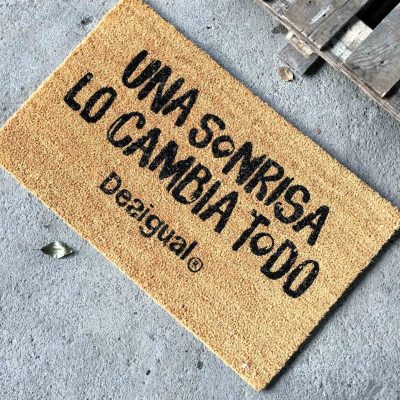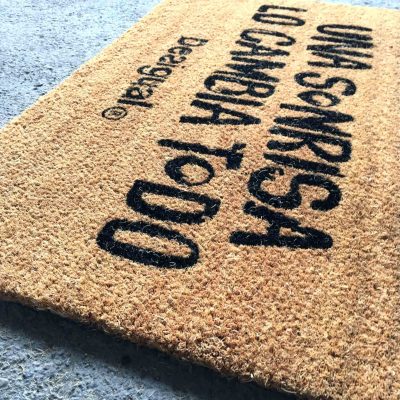Entryway Floor Mats: Keep Dirt and Mud Outside
Your entryway is the gateway to your home, and it’s often the first place visitors see when they arrive. It’s also the area most exposed to dirt, mud, and debris, especially during rainy or snowy seasons. Entryway floor mats are an essential part of maintaining a clean, organized home by providing a simple yet effective solution to keep dirt, moisture, and grime from being tracked indoors. But beyond their practical function, the right entryway mat can also enhance the aesthetic of your entryway and make a lasting first impression.
In this guide, we’ll explore the importance of choosing the right entryway floor mat, the benefits they offer, and tips on selecting the perfect one for your home.
1. Why Entryway Floor Mats are Essential
a. Protect Your Floors
The primary function of an entryway floor mat is to protect your floors from dirt, mud, and moisture. When you and your guests step inside, shoes often carry in dirt, water, and debris from the outside. Without a mat, all of this can end up on your hardwood, tile, carpet, or other flooring, causing stains, scratches, and wear over time.
- Ideal for: Hardwood, tile, carpet, or laminate flooring that’s prone to damage from dirt and moisture.
b. Reduce Cleaning Effort
Without a proper entryway mat, dirt and moisture will inevitably spread throughout your home. By placing a mat at the door, you can effectively trap dirt and water before it enters your home, cutting down on the need for frequent cleaning and helping you maintain a tidy, organized space. It’s a small investment that pays off in less time spent cleaning.
- Ideal for: Busy households where cleaning time is at a premium.
c. Safety First
Entryways are high-traffic areas, and wet or muddy floors can become slippery, leading to the risk of slips and falls. A non-slip entryway mat provides traction and helps prevent accidents, especially when the mat is placed in a highly trafficked area that’s prone to water exposure.
- Ideal for: Homes in rainy or snowy climates or for those with elderly residents or young children.
d. First Impressions Matter
The entryway is the first thing guests encounter when they visit your home, and it sets the tone for the rest of your interior. A stylish, well-chosen entryway mat adds a touch of personality and welcomes guests with a sense of warmth and comfort.
- Ideal for: Homeowners who want to combine functionality with style.
2. Types of Entryway Mats
There’s no one-size-fits-all solution when it comes to choosing an entryway mat. The best mat for your home will depend on several factors, including your style preferences, the climate in your area, and the amount of foot traffic your entryway experiences. Here are the most popular types of entryway mats:
a. Coir Mats
Made from the husk of coconuts, coir mats are a natural, eco-friendly option that excels at scraping dirt and mud off shoes. Their rough texture effectively traps debris, and they’re highly durable, making them an excellent choice for outdoor or highly trafficked entryways. Coir mats are also moisture-resistant, which helps them hold up in wet weather.
- Best for: Outdoor entryways, especially in areas with heavy foot traffic or rainy/snowy climates.
- Pros: Durable, eco-friendly, effective at scraping dirt, moisture-resistant.
- Cons: Can be rough underfoot and may shed fibers initially.
b. Rubber Mats
Rubber entryway mats are an excellent choice for high-traffic areas that are exposed to the elements. Rubber is durable, water-resistant, and easy to clean, making it perfect for wet or muddy conditions. Many rubber mats come with raised, textured surfaces that help trap dirt and water, keeping your floors dry.
- Best for: Outdoor or covered entryways, homes in wet climates, or areas prone to heavy dirt and debris.
- Pros: Non-slip, water-resistant, easy to clean, highly durable.
- Cons: Can have a more industrial look, less decorative.
c. Fabric or Microfiber Mats
Fabric-based mats, including those made from microfiber or cotton, are soft and comfortable underfoot, and they absorb moisture well. These mats can be a great option for indoor entryways that don’t see heavy outdoor dirt but still need a mat to trap water or dust from shoes. Many fabric mats are machine-washable, making them easy to clean.
- Best for: Indoor entryways with moderate foot traffic or areas that don’t face heavy outdoor exposure.
- Pros: Soft and absorbent, easy to clean, often available in decorative patterns.
- Cons: Not as durable in outdoor conditions, may require frequent washing.
d. Dirt Trapper Mats
Dirt trapper mats are designed specifically to capture and hold dirt, mud, and moisture. These mats typically have deep grooves, ridges, or textured surfaces that “trap” debris and water, preventing it from being tracked further into your home. They are ideal for wet or muddy environments, as they help ensure a cleaner, drier home.
- Best for: Homes in rainy or snowy climates, homes with pets, or high-traffic entryways.
- Pros: High dirt- and moisture-absorption, non-slip backing, easy to clean.
- Cons: Can be bulkier and may not fit in more delicate or high-style spaces.
e. Personalized Entry Mats
For those who want to add a touch of personality to their entryway, personalized entry mats are a great choice. These mats can feature custom text (such as your family name or a welcoming phrase) or designs that match your home’s aesthetic. Personalized mats often come in a range of materials, from coir to fabric, making them versatile and customizable.
- Best for: Homeowners who want to make a personal statement or add a welcoming touch.
- Pros: Unique, customizable, can add a personal touch to your entryway.
- Cons: May be less functional for high-mud areas (depending on material).








